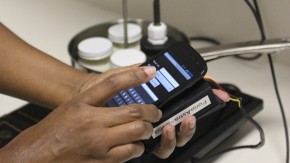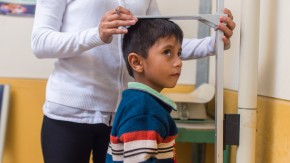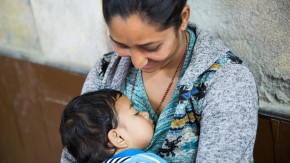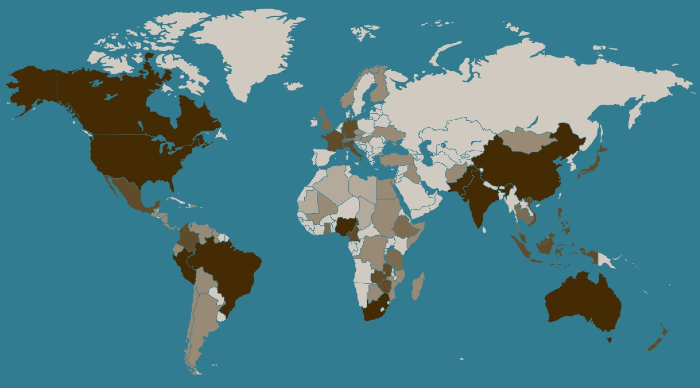Diagnosing Pneumonia
- Zach Charat, Mar 9, 2020

Your average doctor goes through four intense years of medical school and then somewhere between three and five years of grueling residency to become an expert at diagnosing and treating illness. When she puts the stethoscope to your chest, listens to you cough, and tells you what's making you sick, she's basing her diagnosis on at least a decade of experience and training. And, as Dr. Udantha Abeyratne at Australia's University of Queensland is discovering, your cell phone is getting closer and closer to being able to do just as good a job.
One disease that's particularly hard for human doctors to diagnose is pneumonia; even highly trained specialists looking at X-ray images can disagree about whether it's pneumonia or something else that's making a patient cough. For community healthcare workers in poor countries who lack advanced training and expensive equipment, accurately diagnosing pneumonia can be impossible - but it's one of the common reasons kids come to them with a cough. In fact, the World Health Organization guidelines suggest that if children come in complaining of a cough and are taking more than a certain number of breaths a minute, healthcare workers should just go ahead and treat them for pneumonia. It's an understandable precaution; a million kids die every year of pneumonia.
For children who actually have pneumonia, this is great; they get the medicine they need quickly. But for clinics using the WHO guidelines, as many as 80% of the kids diagnosed with pneumonia actually have other diseases that cause coughing and quick breathing, including (but not limited to) malaria, asthma, diphtheria, and tuberculosis. A kid with one of those diseases who gets treated for pneumonia isn't just being treated for a disease she doesn't have; she's also not being treated for a disease she does have - and she'll continue to get sicker until somebody realizes what's going on. Not only that, but taking antibiotics for a disease you don't have helps bacteria grow more resistant to those antibiotics. Approximately 700,000 people already die from antibiotic-resistant infections every year - and by 2050, the annual death toll could be as high as 10 million.
Dr. Abeyratne is not an expert in pneumonia; he's an expert in medical instrumentation and diagnostic technologies, especially those based on acoustical analysis, and for many years he's been working on diagnosing sleep apnea. He knew that a regular snore and a snore caused by sleep apnea sound very slightly different - different enough that he had developed a tool that a computer could use to diagnose sleep apnea by analyzing the sound of snoring. When he learned about the challenges diagnosing pneumonia presented, he wondered: could a computer tell the difference between a pneumonia cough and other kinds of coughs? In 2009, when we issued a Grand Challenges Explorations call for proposals to develop inexpensive diagnostics for priority health conditions, with a specific need for ideas that included complex signature analysis for pneumonia using respiratory acoustics, he came to us with a hypothesis that it could. He won the grant, along with 39 others from a total of 8 countries, and got to work.
Partnering with a hospital in Indonesia, he collected recordings of the coughs of 160 kids with pneumonia, bronchiolitis, bronchitis, asthma, and other respiratory diseases. When he analyzed the audio with a computer algorithm he developed with his team, he found that pneumonia coughs and non-pneumonia coughs do sound different: In pneumonia, tiny air sacs in the lung are filled with fluids, and that causes certain changes to your coughing. Meanwhile, in asthma, for example, often diagnosed in remote regions as pneumonia, tiny airways in the lungs constrict, which causes different changes to your coughing. The difference between the two kinds of cough is subtle enough that only very well-trained human ears can perceive it, but it's easier for a computer to detect.
Once Dr. Abeyratne's grant at the foundation was finished in 2011, the University of Queensland stepped in with support, and he continued to refine his algorithm until it diagnosed pneumonia much more accurately than someone using just the WHO guidelines. With the support of hospitals in Western Australia, he and his team expanded the algorithm so that it could diagnose not just pneumonia but also bronchiolitis, asthma, croup, COPD, and other respiratory diseases. They then created a smartphone-based diagnostic test, ResApp, which recently received regulatory approval for the European Union; a US FDA application is pending.
As time goes on, it seems like there are more and more mobile phone apps designed to do completely unnecessary things. Nobody needs an easier way to put cat ears on their digital photos. But alongside the useless apps, there are some that are incredibly important. Thanks in part to Dr. Abeyratne's work, someday soon this could include apps for making sure that kids in places that lack experienced doctors get treated for the right illness.
Explore More Grand Challenges Explorations (2008-2018)

Banking Human Milk
Mar 9, 2020
Diagnosing Leaky Gut
Mar 9, 2020
Eliminating Witchweed
Mar 9, 2020
